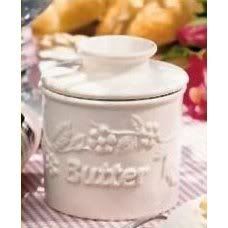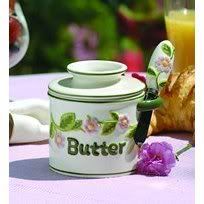...soft, fresh butter to go on it!
Our family has just discovered a wonderful little kitchen accessory - a butter keeper. Ever heard of it? It's a device that keeps butter fresh at room temperature, leaving it soft and spreadable. It's two pieces, one piece being the dish that holds the butter. This piece then flips upside down into a slightly larger dish, which you fill with about 1/2 inch of cool water. The water then seals in the butter to keep it fresh!
Clever, isn't it? We have found, however, that you do have to consistently change the water every few days, and it helps to use the butter up fairly quickly, as it only stays fresh for so long. It keeps fresh for about a week, I would say, before it starts to turn rancid. Most butter keepers that I have seen hold one stick of butter (1/2 cup).
Here are a few butter keepers I found on Amazon.com. For a more extensive selection, click on this link: Butter Keepers on Amazon (note that there are a few other butter-related products listed that just came up in the search results).
(note that there are a few other butter-related products listed that just came up in the search results).
 Butter Keeper
Butter Keeper White Floral Butter Keeper
White Floral Butter Keeper Floral Butter Keeper with Knife
Floral Butter Keeper with Knife Of course, to be frugal you can also pack the butter into a regular bowl, and then fit it into a larger bowl filled with 1/2 an inch of water as well. It just wouldn't be as "pretty." :-)